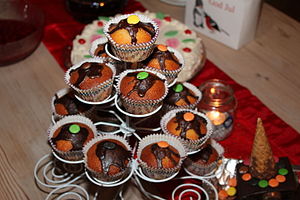This is an old revision of this page, as edited by Mothperson (talk | contribs) at 14:55, 27 May 2005 (revised wordings). The present address (URL) is a permanent link to this revision, which may differ significantly from the current revision.
Revision as of 14:55, 27 May 2005 by Mothperson (talk | contribs) (revised wordings)(diff) ← Previous revision | Latest revision (diff) | Newer revision → (diff)
The word muffin is given to two types of breadstuffs, one a yeast-leavened item, and the other a "quick" bread raised with baking powder or baking soda.
The yeast-raised muffin is the older version, appearing as a word in Britain around the 11th century A.D. Moufflet in Old French meant "soft" in reference to bread. The other type of muffin is an American development from the 19th century, made possible by the invention of baking powder.
The British yeasted version, which is what the nursery rhyme muffin man was selling, is predecessor to what is known in American English as the English muffin. It is a thick, flat bun, typically about 8 cm in diameter. This muffin is usually split into two, toasted and buttered, and bears resemblance to the crumpet or pikelet.
American muffins may have started out as a form of small cake, or possibly an adaptation of cornbread. Early versions of these muffins tend to be less sweet and much less varied in ingredients than their contemporary forms. Made quickly and easily, they were useful as a breakfast food. They also rapidly grew stale, which prevented them from being a marketable baked good, and they were not seen much outside home kitchens until the mid-20th century. Recipes tended to be limited to different grains (corn, wheat bran, or oatmeal) and a few readily available additives (raisins, apples in some form, or nuts).
In the 1950s, packaged muffin mixes were introduced by several American companies. By the 1960s, attempts were being made to treat the muffin like the doughnut as a franchise food business opportunity. Coffee shop-style restaurant chains appeared, featuring a a wide variety of muffins. These tended to be regional, such as The Pewter Pot in southern New England. No such business has emerged nationally in the U.S. (although doughnut chains have edged into the business), but Australia's Muffin Break has spread to New Zealand and the U.K., featuring the American-style muffin.
A somewhat odd combination of circumstances in the 1970s and 1980s led to significant changes in what had been a rather simple, if not prosaic, food. The decline in home-baking, the health food movement, the rise of the specialty food shop, and the gourmet coffee trend (exemplified by Starbucks) all contributed to the creation of what is now the standard contemporary muffin. Preservatives in muffin mixes led to the expectation that muffins did not have to go stale within hours of baking, but the resulting muffins were not a taste improvement over homemade. On the other hand, the baked muffin, even if from a mix, seemed almost good for one compared to the fat-laden alternatives of doughnuts and Danish pastry. "Healthful" muffin recipes using whole grains and such "natural" things as yoghurt and various vegetables evolved rapidly. But for "healthy" muffins to have any shelf-life without artificial preservatives, the sugar and fat content needed to be increased. The rising market for gourmet snacks to accompany gourmet coffees resulted in fancier concoctions in greater bulk than the original modestly-sized corn muffin. Today it is not unusual to find a muffin along the lines of "coconut-almond-cherry-chocolate" the size of a small baby's head.
Orange Choc-Chip Muffins
| This page is a candidate for copying over to the Wikibooks Cookbook using the Import process. If the page can be edited into an encyclopedic article, rather than simply a recipe, please do so and remove this message. To facilitate the copying of this article, please consider listing it on Wikibooks:Requests for Import. Check to see if the cookbook already has a page about this recipe or ingredient and alternatively use a soft redirect if appropriate. |
- 400g self-raising flour
- 60g butter
- 120g sugar
- 12cL cup milk chocolate bits
- 12cL cup white chocolate bits
- 2 eggs, beaten lightly
- 12cL cup milk
- 12cL cup orange juice
- 15mL orange rind
Preheat oven to 220ºC. Sift flour onto bowl, rub in butter. Add sugar, chocolate bits, eggs, milk, orange juice, and orange rind. Mix well. Spoon heaped tablespoons of mixture into greased muffin pans. Bake for 15-20 minutes until cooked when tasted. Makes 12.
State Muffins
Several states of the United States have a state muffin:
- Minnesota - blueberry muffin
- Massachusetts - corn muffin
- New York - apple muffin